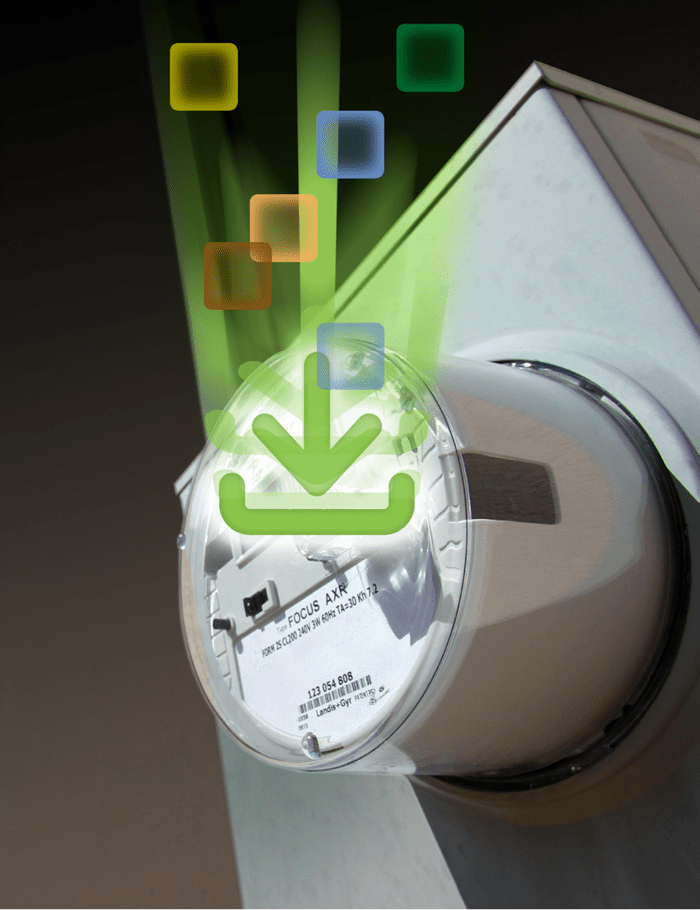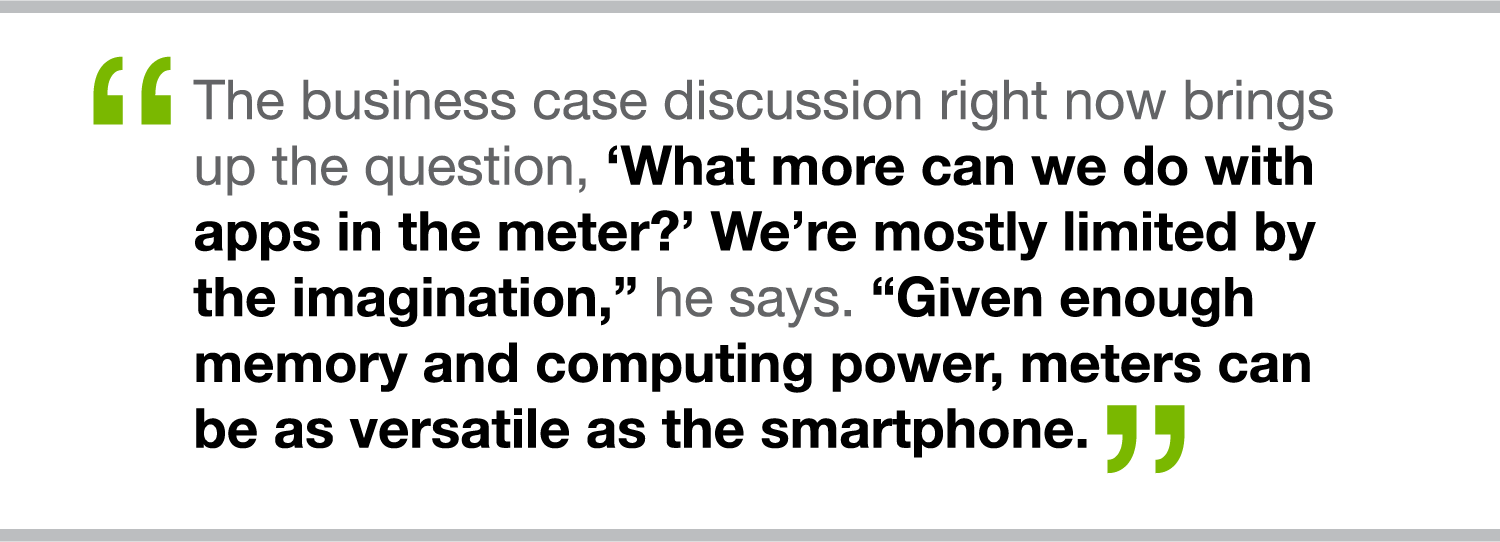As of March 2017, Android smartphone users could pick and choose between 2.8 million apps, while those who find their extras in Apple’s App Store had 2.2 million options available. For those of us who use apps daily to wake up, hear music, board planes, shop, and more, it’s hard to believe the Apple App Store has not yet hit its 10th anniversary. That happens this coming July.
Still, the average smartphone user accesses nine apps per day and 30 through the course of a month, according to research from App Annie, a consultancy focused on the app market. People recognize that their smartphones are little computers, able to have functionality added quickly and easily with software or firmware downloads.
Utilities should start thinking of their meters the way people see their smartphones, says John Radgowski, vice president of solutions product management at Landis+Gyr. Small amounts of coding can deliver countless capabilities, he explains, noting that app stores are constantly evolving. For utilities, some smart meter apps get written in-house by staff, while others have already been developed by vendors. But, like apps for a smartphone, there are always more apps that can be developed. “There is an infinite number of things you can do,” Radgowski says.
 Under separate cover
Under separate cover
Unlike early AMI systems that lacked the on-board computing power and memory to run software applications, today’s smart meters possess the ability to “download” apps from the network and run the code autonomously. Those apps can be used to change the communication protocol of the meter or device, if desired, to allow it to interface with other utility or consumer networks. “Your smartphone has multiple communications options built in,” explains Radgowski. “You can use Wi-Fi, cellular, Bluetooth, and you don’t lose application capability. You don’t have applications just disappear.” Even if functionality changes somewhat, you can still check email, manage your calendar, and perform other tasks regardless of what communications standard you’re using to access the internet.
That’s the kind of communications flexibility Radgowski sees as crucial to app opportunity. Once you have it, you can manage both firmware and software, changing the nature of a metering device with a simple download.
Arizona Public Service, for instance, is the first utility in the U.S. to pilot ownership and control of residential rooftop solar installations. Late in 2014, the utility began its Solar Partners Program, which started with some 1,500 residential customers who received their own PV systems from 4 kilowatts to 8 kilowatts in size. Essentially, the utility purchased and owned the rooftop generation equipment, giving consumers $30 each month in credit on their electric bills for 20 years.
Each PV system also had a smart inverter, which APS connected to its supervisory control and data acquisition (SCADA) system to facilitate utility control of the generation resources to equipment deferment, voltage management, and more.
The challenge? Those inverters communicated via the Modbus protocol, while APS’ SCADA system speaks Distributed Network Protocol, or DNP3. “APS didn’t want to change its SCADA system or its standards, so we wrote a small application to convert the speak of the smart inverters and enable them to talk to the utility control system,” Radgowski explains.
“No other utility has ever controlled residential smart inverters using their own controls,” Sanket Adhikari, technology innovation program consultant at APS, told Greentech Media in 2016. “Here, APS is using its own communication equipment. We have our own centralized system that collects the data directly for the utility, and it has the ability of sending the controls out to make the settings change on the smart inverters.”
 Pay it forward
Pay it forward
Salt River Project, another Arizona utility, also is leveraging its AMI system via apps to deliver more value for customers. “SRP wanted to implement a pre-payment plan, but a lot of these programs require a customer to have internet access. That puts a burden on the customer to participate,” says Radgowski. The solution? SRP worked with its meter provider, Landis+Gyr, to implement a meter-based application that does all the meter’s calculations in real time and can push that information to a display in the home and be accessed from a mobile phone.
This same utility also used a meter-based app to role out an innovative residential demand rate. The app helps consumers more easily manage usage during demand periods. “The way demand charges work is that once you hit that high-water mark — whether you’re there for 15 minutes or an hour — you have to pay on that demand for a certain period of time,” Radgowski explains.
“Commercial customers have energy managers who know how to deal with these charges. Residential customers don’t,” he adds. The app SRP implemented resides in the meter and keeps track of demand periods for the customer. During a demand period, the meter automatically can adjust linked HVAC and other high use appliances. The meter monitors consumption, calculates what demand is going to be, and controls household appliances to ensure that the consumer’s target demand is met.
“With an application, SRP can turn meters into home energy management systems,” Radgowski says.
Versatility expands value
Beyond customer premises, utilities are using meter-based apps as distribution system sensors that monitor circuits, feeders, and substations. For instance, Radgowski points out that utilities are beginning to use apps to turn C&I meters into low-cost distribution monitors and sensors. “They may not be able to justify a multi-thousand-dollar capacitor bank controller, but they want to know when the capacitor is open of closed, so they use the meter, a very cost-effective approach.”
The flexibility and functionality apps add to metering systems expands the business case dramatically. For utilities considering an AMI system upgrade, that’s vital.
“Utilities have already cashed the check on a lot of the operational benefits of remote metering, like workforce reductions, outage management, volt-VAR optimization, and other things that make the utility more efficient,” Radgowskil says. He adds that now apps can bring value through more customer-focused benefits.

Integration of renewables is one. “If I can help a customer control demand, then I can have a residential demand charge, which means I can have more renewables,” he explains.
Or, apps could be used for disaggregation of loads by isolating the demand of specific devices, allowing utilities to offer — and charge for — thinks like sump pump and electric water heater monitoring.
Along the same lines, utilities could offer consumers bill forecasting services, allowing people to anticipate a high bill before it comes so they can crank down the air conditioner or take other action. After all, with apps embedded in meters themselves, customers are able to get real-time information and take action right away.
Radgowski says the business case for advanced metering has become far more focused on direct consumer benefit, in part because utilities now have the ability to add apps that give consumers more insight and control.
“The business case discussion right now brings up the question, ‘What more can we do with apps in the meter?’ We’re mostly limited by the imagination,” he says. “Given enough memory and computing power, meters can be as versatile as the smartphone.”